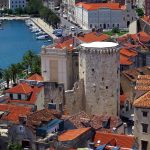Croatia is one of the least prosperous nations in Europe – the opening sentence of an analysis of Croatia from a study on the prospects of improving competitiveness in the Balkans by the Vienna Institute for International Economic Studies (WIIW)
This claim is supported by data showing the Croatian GDP amounting to half the German one, while being up to two-thirds in the beginning of 1980s, Index.hr reported on July 3, 2016.
The Austrian institute writes that Croatia, unlike other Western Balkan countries had a constant growth of deficit and export has been stagnating since 2005, below average for the Western Balkans and far below the average for new EU members from Central Europe. The Vienna Institute does note Croatia exports goods of higher quality, but that Croatian shipbuilding, as an important export point, had to be reduced with EU membership.
The study praises public administration for advances in the past years, attributed to EU membership, but also an impressive highway network, large railway network and education ad innovation indicators making Croatia among the first in the Western Balkans, but still under the average for new EU members.
The Croatian political scene is characterised by a paralysing polarisation between two political camps, the study says and concludes there are almost no differences in the economic policies of HDZ and SDP. “The main point of rupture between the ‘red’ and ‘black’ is the interpretation of events during and after the Second World War,” the Institute notes and adds confidence in government, as a result of the economic crisis, is among the lowest in Europe.
The Croatia analysis points out that the share of loans in foreign currency is over 70% of GDP and that public debt is the highest in the Western Balkans, leaving little room for the National Bank to change monetary policy. It adds that Croatia has done little to modernise its labour market, but that direct investments by foreign investors are underway, mentioning the LNG terminal construction on Krk island.
Croatian strengths are seen in tourism, ports, agriculture, foresting, energy and mining as well as human resources. The list of weaknesses is long. The industrial sector oriented to export could be bigger, the business sector is moderately developed, the quality of public institutions and public infrastructure could be better, while the absorption capacity of the Croatia labour market is limited.
Croatian opportunities include the “picturesque coast”, fit for trade and tourism as well as forests and fields, but also energy resources as well as the Danube connecting Central and South-eastern Europe. EU membership is also an opportunity. Threats are seen in the neighbouring politically unstable states, but also the domestic burden of past conflicts.
Concrete measures are suggested in the study, with those marked as imperative being quite interesting as they cost little and bring plenty of benefits. Some of them are a reform of the personal bankruptcy law, the advancement of EU funds withdrawal through administrative reform, deemed especially important.
Some short term measures include weakening the Kuna towards the Euro, shielding the destabilisation of capital inflow and useful for export, with an alternative in fiscal devaluation, or tax reform.
In the end, the Institute cites top five recommendations to increase competitiveness and restarting the economy:
1. Salary policy based on an agreement between social partners (expensive, long term)
2. Investments in a dual system of education and prequalification (expensive, long term)
3. Stronger withdrawal of EU funds (cheap, long term)
4. Reduction of bad loans (cheap, short term)
5. Fiscal devaluation (cheap, short term, possible political confrontation).







